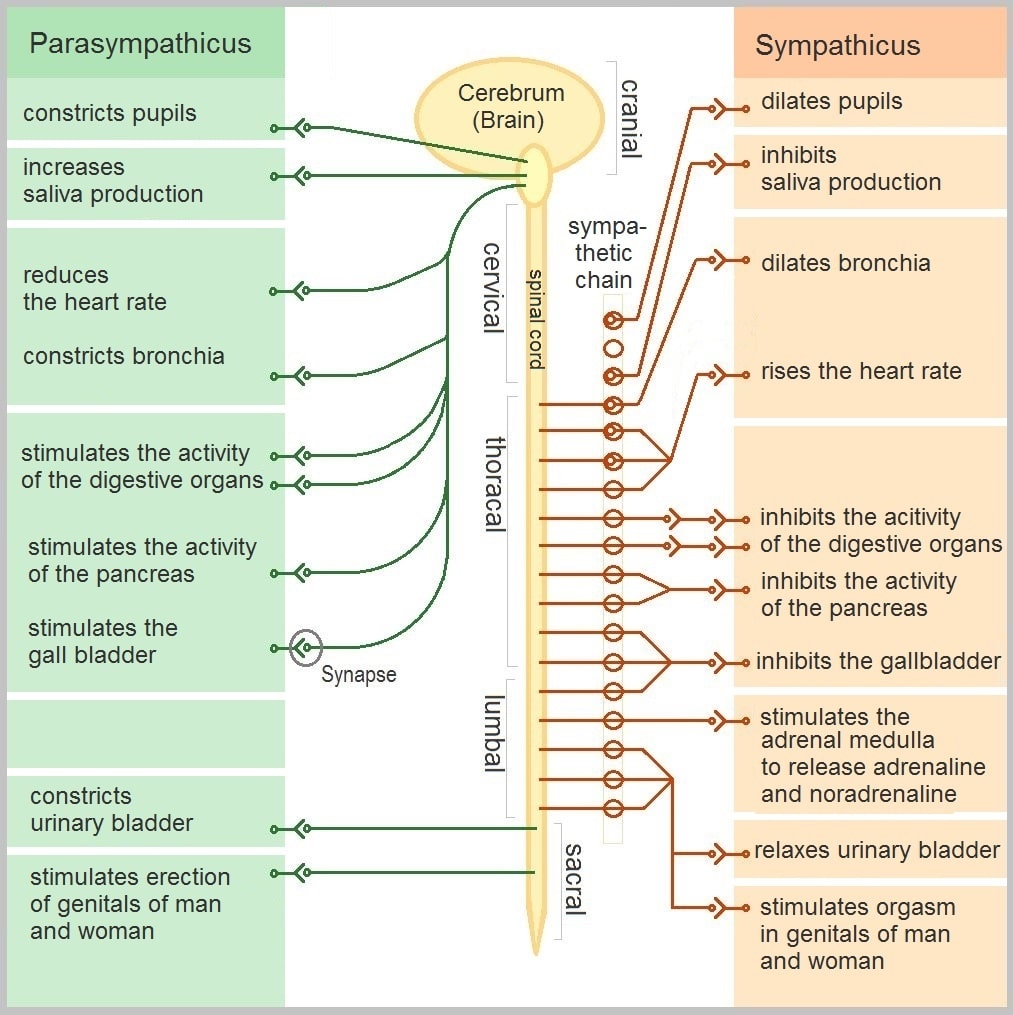Describe the Structure of the Autonomic Nervous System
The preganglionic neuronal cell bodies are located in the gray matter of the thoracic and lumbar segments of the spinal cord. An autonomic nervous system is comprised of visceral motor neurons that send signals to smooth muscle cardiac muscle and glands plus Muscles and glands possess these visceral effectors with muscles either.

Overview Of The Autonomic Nervous System Brain Spinal Cord And Nerve Disorders Msd Manual Consumer Version
Structure of Nerve Fibers.

. This is composed of thick myelinated nerve fibers. Ad Over 27000 video lessons and other resources youre guaranteed to find what you need. The sympathetic nervous system activates the fight or flight response during a threat or perceived danger and the parasympathetic nervous system restores the body to a state of calm.
The autonomic nervous system is a division of peripheral nervous system that is not under voluntary control. The sympathetic division of the ANS is called the thoracolumbar division because. Anatomy and Physiology questions and answers.
It is often regarded as a self-regulating system. The autonomic nervous system ANS is responsible for involuntary control of the body usually for the sake of homeostasis regulation of the internal environment. Autonomic nerve pathway involves two nerve cells.
The autonomic nervous system ANS is a division of the peripheral nervous system that supplies smooth muscle and glands and thus influences the function of internal organs. The autonomic nervous system regulates many of the internal organs through a balance of two aspects or divisions. Hence the preganglionic neurone must first travel to and synapse upon a ganglion a collection of neuronal cell bodies in the PNS.
It is divided into two branches. Sensory input for autonomic functions can be from sensory structures tuned to external or internal environmental stimuli. The autonomic nervous system is composed of two neurons with a single synapse between the CNS and the effector organ.
The sympathetic nervous system is responsible for preparing the body for fight-or-flight and is activated by stress or. This is composed of both thin and thick myelinated nerve fibers. It controls the functions of internal body organs such as stomach heart lungs urinary bladder etc.
Innervates cardiac muscle smooth muscle exocrineendocrine glands and adipose tissueviscera. Many nerves of the parasympathetic portion of the autonomic nervous system begin in the nuclei in your brainstem. Autonomic nervous system functional division of the efferent branch of the PNS that is responsible for control of cardiac and smooth muscle as well as glandular tissue brain the large organ of the central nervous system contained within the cranium and continuous with the spinal cord central nervous system CNS.
Divisions functions and diseases of the autonomic nervous system. Sacral spinal cord output. The sympathetic nervous system and the parasympathetic nervous system.
A ganglion then gives rise to a postganglionic neurone which innervates the target organ. The autonomic nervous system ANS is a functional division of the nervous system with its structural parts in both the central nervous system CNS and the peripheral nervous system PNS. The digestive system has a big job to do.
The autonomic nervous system is the involuntary part of the peripheral nervous system. The autonomic nervous system is a component of the peripheral nervous system that regulates involuntary physiologic processes including heart rate blood pressure respiration digestion and sexual arousal. Function of the Autonomic Nervous System.
The Autonomic Nervous System Describe the organization of autonomic motor neurons Describe how neural regulation of smooth and cardiac muscle differs from neural regulation of skeletal muscles Know the structure of the sympathetic nervous system understanding the location of. Much of the function of the autonomic system is based on the connections within an autonomic or visceral reflex. This is why its also called the visceral nervous system.
Using the sensory input the ANS control centers develop appropriate responses reflexes which are then relayed to autonomic motor neurons. Further divided into the sympathetic SANS parasympathetic PANS systems it is comprised exclusively of visceral motor fibers. Sympathetic parasympathetic and enteric.
It controls the glands and smooth muscle of all the internal organs viscera unconsciously. Breathing will return to normal. It contains three anatomically distinct divisions.
Autonomic Nervous System. The autonomic nervous system comprises two parts- the sympathetic and parasympathetic nervous system. The ENS is capable of autonomous functions such as the coordination of reflexes.
Autonomic motor neurons carry signals out of the CNS to the heat glands and smooth muscle. Textbook Solutions Expert Tutors Earn. 67 Describe the basic structure of the autonomic nervous system and its role in from BIO L1008 at The University of Sydney.
Neurogastroenterology is the study of the enteric nervous system a subdivision of the autonomic nervous system ANS that directly controls the gastrointestinal system. Autonomic sensory neurons conduct signals from the visceral receptors to the CNS. The gastrointestinal GI system has its own nervous system the enteric nervous system ENS.
Neurons that innervate skeletal muscle 2. One cell is located i View the full answer. The autonomic nervous system has a unique structure as it employs a sequential two-neurone efferent pathway.
The axons of the preganglionic neurons control thoracolumbar inflow. The autonomic nervous system ANS provides motor functions for some cranial and spinal nerves which makes it part of the peripheral nervous system. The autonomic nervous system is a subdivision of the peripheral nervous system that regulates the bodys internal organs.

Divisions Of The Autonomic Nervous System Anatomy And Physiology I

The Autonomic Nervous System Sympathetic And Parasympathetic Divisions Youtube

Peripheral Nervous System Structure Summary Teachmephys

Autonomic Nervous System Function And Divisions Biology Dictionary
Comments
Post a Comment